Common Spiders in Sacramento, CA
Are you curious about the eight-legged creatures that share your Sacramento home? From the harmless common house spider to the infamous black widow, we’ll discuss the roles these spiders play in our ecosystem and the potential risks they pose.
Key Takeaways
- Common spiders in Sacramento include house spiders, yellow sac spiders, jumping spiders, wolf spiders, and black widow spiders.
- The black widow spider is the primary dangerous species in the region, but it is not aggressive and usually bites only when threatened or disturbed.
- To prevent spider infestations, seal potential entry points, eliminate hiding spots, and clean your home regularly.
- For severe infestations or concerns, seeking professional help from pest control experts is crucial.
– – –
🐜 Sacramento Spider Control Service
Get Your First Service For Only $67
Limited Time Offer
– – –
Common Spiders in Sacramento
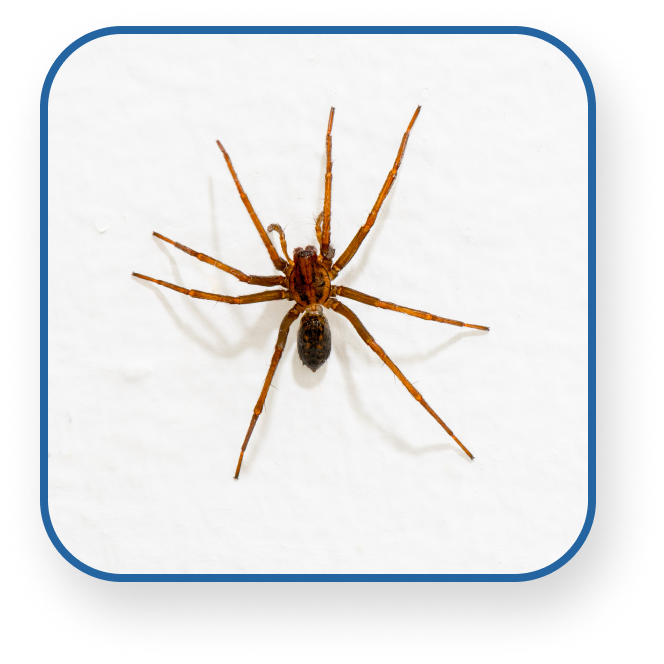
Common House Spiders
Appearance
Common house spiders (Parasteatoda tepidariorum) are typically brown or gray with various markings and patterns on their bodies. They have a slightly rounded abdomen and measure around 1/8 to 3/8 inches in length. Males tend to be smaller and slimmer compared to the larger-bodied females. The Cellar Spider (a.k.a. Daddy Long Legs) falls under this umbrella.
Behavior
These spiders are known for their distinctive cobwebs, which they spin in corners, crevices, and other sheltered areas. They are non-aggressive and rarely bite humans. If they do, the bites are usually painless and pose no significant threat. Common house spiders feed on various small insects, helping control their populations indoors.
Habitat
As expected, common house spiders are frequently found in homes, particularly in basements, attics, and garages. They prefer dark and secluded areas where they can spin their webs undisturbed. Besides residential spaces, they can also be found in barns, sheds, and other outdoor structures.
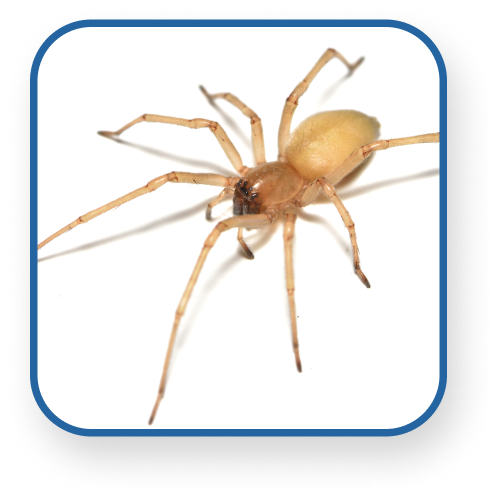
Yellow Sac Spiders
Appearance
Yellow sac spiders (Cheiracanthium inclusum) have a pale yellow or beige body with a slightly darker stripe running down the length of their abdomen. They have long, slender legs that are darker in color towards the tips. These spiders are tiny, measuring about 1/4 to 3/8 inches in length.
Behavior
Yellow sac spiders are nocturnal hunters that actively pursue their prey instead of relying on webs. They feed on insects such as flies and ants. Although their venom is not highly toxic to humans, their bites can hurt and cause redness, swelling, and itchiness. However, severe reactions are rare; most bites heal within a few days.
Habitat
These spiders are commonly found both indoors and outdoors. Inside homes, they prefer quiet, secluded areas such as corners, ceilings, or window frames. Outdoors, they can be found in gardens, shrubs, and other vegetation. Yellow sac spiders create small, silk sacs to rest in during the day, which explains their names.
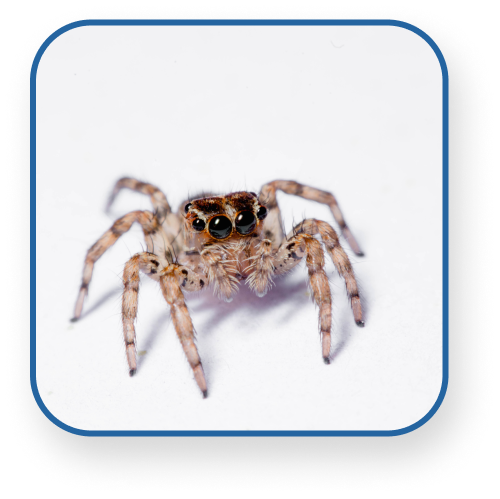
Jumping Spiders
Appearance
Jumping spiders (family Salticidae) are small, compact, and furry with various colors and patterns. They’re small, ranging from 1/8 to 3/4 inches in length. These spiders are known for their large, forward-facing eyes, providing excellent vision to detect and stalk their prey.
Behavior
Jumping spiders are active hunters that rely on their remarkable jumping ability to pounce on their prey, which includes insects and other spiders. They do not build webs for prey but may create small silken shelters for resting or laying eggs. Jumping spiders are harmless to humans, and their bites are rare and usually painless.
Habitat
Jumping spiders are versatile and adaptable, inhabiting various indoor and outdoor environments. Inside homes, they can be found near windows or other well-lit areas where they can easily spot their prey. Outdoors, they are commonly found on plants, fences, or walls, often basking in the sun.
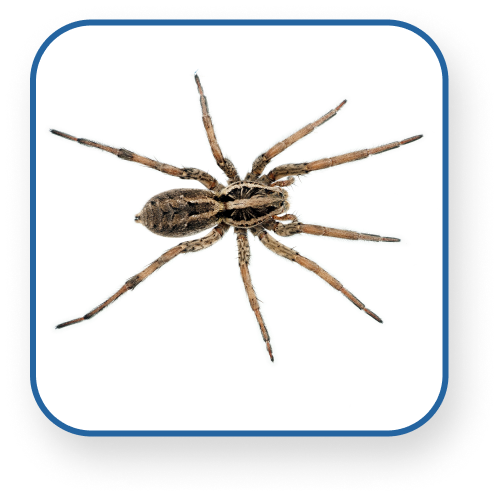
Wolf Spiders
Appearance
Wolf spiders (family Lycosidae) are large, robust spiders with a brown or gray coloration, often featuring various markings or stripes on their bodies. Their size ranges from 1/4 to over 1 inch in length. Wolf spiders have a distinct eye pattern, with two large, forward-facing eyes and six smaller eyes arranged in two rows.
Behavior
Wolf spiders are active hunters that rely on speed and agility to catch their prey, which includes insects and other arachnids. They do not build webs but chase and pounce on their victims. Wolf spiders are known for their excellent eyesight and keen sense of touch, which help them navigate and detect potential prey. Although their bites can hurt, they are not dangerous to humans and rarely cause severe symptoms.
Habitat
Wolf spiders inhabit various environments, from forests and grasslands to suburban gardens and residential areas. They are often found under rocks, logs, or leaf litter, seeking shelter and hunting prey. Inside homes, they may be found in basements, garages, or other dark, secluded spaces.
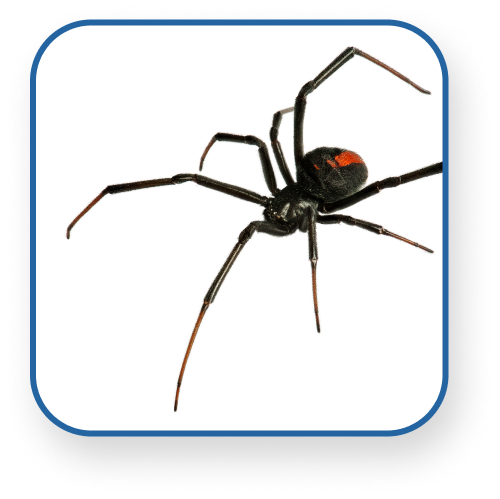
Black Widow Spiders
Appearance
Black widow spiders (Latrodectus mactans) are easily recognizable by their glossy black bodies and the red, hourglass-shaped marking under the female’s abdomen. Adult female black widows, including their legs, measure about 1.5 inches in length. Males are significantly smaller and often lighter in color, with fewer distinct markings.
Behavior
Black widow spiders possess highly potent venom that can lead to severe symptoms, including muscle pain, nausea, and labored breathing. However, bites are rare, and fatalities are even rarer due to the availability of antivenom. Black widows build irregular, tangled webs in sheltered areas to catch their prey, which includes insects and other small arthropods.
Habitat
Black widows are primarily found outdoors in warm, dry climates like California. They prefer dark, secluded areas like woodpiles, sheds, or debris. They may be found in garages, basements, or crawl spaces in residential areas. While it’s uncommon for black widows to venture indoors, they may seek shelter inside homes during extreme weather conditions.
– – –
🐜 Sacramento Spider Control Service
Get Your First Service For Only $67
Limited Time Offer
– – –
Spiders in Sacramento: Friend or Foe?
While spiders in and around our homes may cause discomfort or fear, it is essential to recognize that most are harmless and play a vital role in our ecosystem. They manage insect populations by preying on pests such as flies, mosquitoes, and other spiders.
Dangerous Spiders in Sacramento
In Sacramento, the primary dangerous spider to be aware of is the black widow. Although their bites can cause severe symptoms, black widows are not aggressive and usually only bite when threatened or disturbed. To prevent run-ins with black widows:
- Remove potential hiding spots such as woodpiles, debris, or clutter around your home;
- Be cautious when reaching into dark, hidden spaces like storage boxes or behind furniture; and
- Wear gloves when gardening or handling firewood to protect your hands from accidental bites.
Benefits of Non-Poisonous Spiders
Despite their sometimes creepy appearance, non-poisonous spiders like the common house, yellow sac, jumping, and wolf spiders benefit our environment. These spiders help control insect populations, keeping our homes and gardens free from pests that can damage plants, spread diseases, or become a nuisance.
Maintaining a balance in our ecosystem makes these harmless spiders essential in promoting biodiversity and supporting a healthy environment. So, while it might be challenging to embrace our eight-legged friends, understanding their role and benefits can help us appreciate their presence in our surroundings.
Handling Spider Infestations
Spider infestations can be distressing and inconvenient, especially for those who are afraid of spiders or have allergies to their bites. The following tips can help you manage spider infestations and maintain a spider-free home:
- Identify the source: Look for potential entry points in your home, such as cracks or gaps in the walls, windows, or doors. Sealing these openings can prevent spiders from entering your home in the first place.
- Eliminate hiding spots: Clear away clutter, debris, and unnecessary items inside and outside your home. These actions reduce the number of hiding spots available for spiders, making your home less attractive to them.
- Regular cleaning: Regularly clean your house, paying special attention to corners, ceilings, and other areas where spiders might build their webs. Vacuuming or sweeping away webs can discourage spiders from staying in your home.
- Insect control: Reducing the population of insects in and around your home can make it less attractive to spiders, as they rely on insects for food. Ensure your home is free from food crumbs and standing water, which can attract insects.
- Natural deterrents: Some natural deterrents like peppermint oil, vinegar, or diatomaceous earth can help keep spiders at bay. Apply these substances to areas where spiders are commonly found such as corners and window sills.
Seek Professional Help for Severe Infestations
If you’re dealing with a severe spider infestation or are concerned about dangerous species like black widows, it’s crucial to seek pest control services. Professional exterminators can assess the situation, identify the species involved, and implement effective treatment strategies to safely eliminate infestations and prevent future occurrences.



